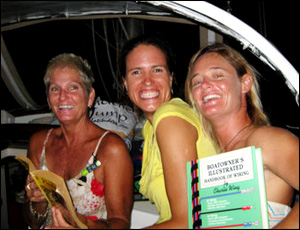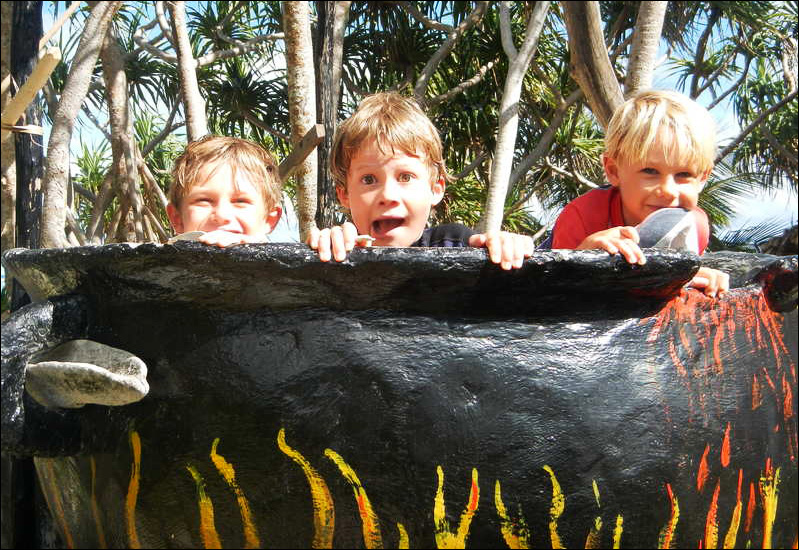 |
| Rub a dub dub? Three sailors in a tub (or, more correctly, a Vanuatu stew pot) |
In light of recent press coverage on the rescue of the Kaufmann family in the Pacific, I’d like to offer a very different (if less spectacular) story as a counterbalance.
My family has spent the past three years living aboard our 1981 Dufour 35, Namani, crossing the Pacific. Our son was seven when the trip started in Maine and is now ten as we wrap up our adventure in Australia. We also lived aboard previously for one year when he was three years old and we crossed the Atlantic.
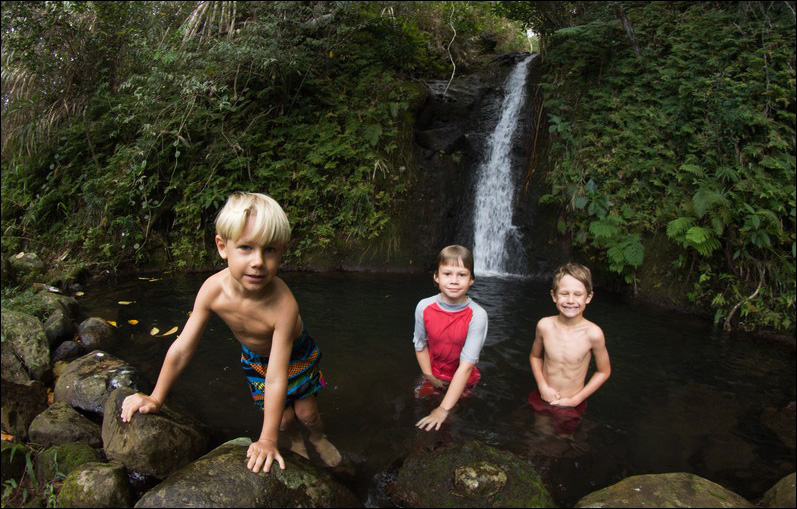 |
| The reward for a hike on Vanuatu: a waterfall swim for Hannes (age 5), Nicky (9) and Niclas (7) |
Both trips have been a magical times that we wouldn’t trade for anything – not just for the travel and the sailing, but most of all for the family time we have enjoyed. Many cruising families we met along the way agree.
It’s too bad the countless happy stories don’t get the same kind of attention that the few negatives do.
So here I offer you an example of how easily a potentially serious child’s health issue was resolved by the cruising community in the Pacific. We were anchored off the island of Taveuni in Fiji along with friends on another boat who sailed from Europe with their two young sons, ages 4 and 7 at that time. One morning, their son Nicolas awoke with badly swollen tonsils. Although the family had a variety of medicines aboard, they were dismayed when they read the fine print of the children’s antibiotic their pediatrician gave them to take aboard. It listed swollen tonsils as one of the few ailments that antibiotic was not recommended for. Since they knew we also carry children’s medication, they called us on the VHF. Happily, our children’s antibiotic did cover tonsil infections, so all we had to do was to row it over to them. Easy.
Meanwhile, another boat in the same anchorage had listened in to our VHF conversation. They knew of a retired doctor aboard yet another vessel in an anchorage a few miles away. Although the doctor wasn’t listening to the VHF at that time, other boats nearby were. Within an hour, the doctor had been found and put in touch with the parents. She assured them that the antibiotic we provided was fine. The doctor also recommended that the family not set off for the remote Lau group as planned, in the small chance that the infection became acute. Thus the parents were able to treat their child and rest easy, not only in the knowledge that a doctor was nearby, but also that staying back was the right thing to do. In the end, they had a lovely time cruising islands they had all to themselves because the bulk of the fleet had gone on to the Lau group.
Not a very spectacular story, but it illustrates several important things.
- First, a well-stocked medical kit is a must, and attention must be paid to details such as an antibiotic’s spectrum of coverage.
- Second, there’s a vast pool of resources within the Pacific cruising community. There are a huge number of boats out there (we rarely had an anchorage to ourselves), and everybody gets to know just about everybody, if not directly then in the second degree.
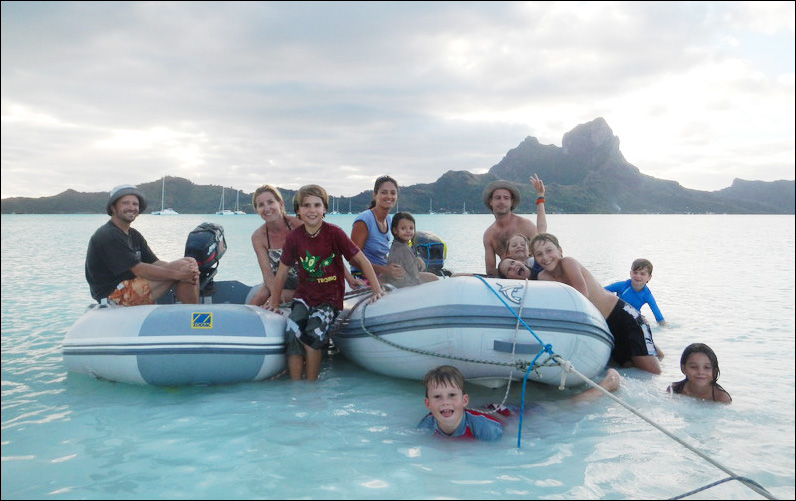
Eight kids from four families and four countries enjoying a play date in Bora Bora. - Third, with communications systems like VHF and SSB radio, you’re never alone. (We believe an SSB is an absolute must despite the cost; with it we were able to have twice daily checks-in with other boats even on our passages. Had anything cropped up then, we could have easily talked to a doctor).
- Finally, it’s a fallacy that remote island communities in the Pacific lack medical facilities. In this day and age, many islands have some sort of regional clinic which sailors can tap in to as needed. You’d be surprised how much help is out there. Case in point: in the sparsely populated Yasawa group of Fiji, there’s a centrally located clinic that friends used when a stomach bug persisted for over a week (for mother and child). They hired a local skiff to take them there (twice the speed, plus local knowledge of the reefs) and saw a UK trained doctor within an hour. Again, easy. Much easier than you would have thought. In Suwarrow, an uninhabited Cook Island popular with cruisers, one man hurt his foot and promptly got stitches from the doctor aboard another boat anchored there. Easy.
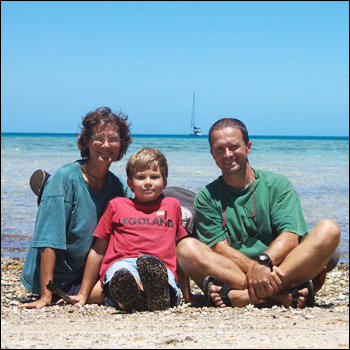 |
| The crew of NAMANI: the author, her husband Markus, and son Nicky on new Caledonia’s Ile Mato |
I can add many more cruising success stories, but I’ll leave it at that for now.
In general, these last three years have been the healthiest and happiest of our lives. We’re been sick far less often than at home, where the germ breeding grounds of school keep us in constant contact with contagious illnesses. We’ve suffered very few injuries because we are careful. We know the potential for risk, and we act accordingly.
I’d say that far more injuries occur in your average neighborhood playground (not to mention the average highway) than out in the cruising grounds of the world, especially if you sail aboard a well-found vessel along prime cruising routes in favorable seasons.
Yes, there’s always a chance that something sometime might go wrong. But given good preparation and care, that chance is no greater than the chance of a freak mishap at home.
When I was in grade school, a childhood friend nearly died of a ruptured appendix because her parents didn’t take her complaints seriously – they were too busy playing tennis! Luckily, all was well in the end. The point is, you don’t need to be in the middle of the Pacific for bad luck to strike. And you don’t have to hope for good luck – you can make your own luck by taking sensible precautions.
Every family must make their own decision about taking children cruising, but whatever you do, don’t let paranoia hold you back.
About Nadine Slavinski
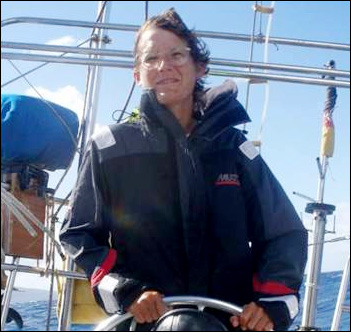 |
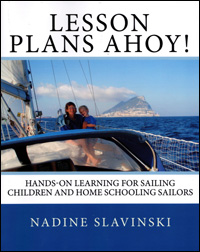 |
Nadine Slavinski is a teacher, parent, and sailor, and the author of Lesson Plans Ahoy: Hands-On Learning for Sailing Children and Home Schooling Sailors.
She is currently in Australia, wrapping up a three year Pacific crossing aboard her 35 foot sloop, Namani, together with her husband and ten year old son. She’ll be heading back to work at an international school in Germany soon.
Her next projects include two more books: watch for Pacific Crossing Notes: A Sailor’s Guide to the Coconut Milk Run and The Silver Spider, a novel of sailing, adventure, and suspense.
For more information, visit her family’s sailing blog at www.namaniatsea.net or her author website at www.nslavinski.com.
More from this website
- Cruising families rally in support of sailing with children and of the ‘Rebel Heart’ family
- Nadine Slavinski answers 12 questions on sailing as a family aboard NAMANI
- Video: Kids speak their own minds about cruising, by Nadine Slavinski
- 6 Tips for home-schooling sailors, by Nadine Slavinski
- Cruising children speak: Cruising children tell us about their experiences growing up aboard

